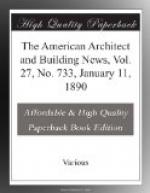With the advent of Christ came new ideas which caused new departures, not only in religious and monastic architecture, but in civil architecture, as well. Christianity, in proclaiming a new virtue, love, created retreats for the unfortunate, asylums for their reception and hospitals for their care. Monkish orders, in their efforts to prevent the destruction of old manuscripts, spread knowledge around them, and following the example set by them in their monasteries, outside colleges were founded. With the dissemination of knowledge, cities roused out of their long sleep; their independent spirit began to shake off the yoke of their oppressors; they formed themselves into communes and various privileges were granted them. Under certain conditions, and in consideration of the discharge of certain obligations, the commune is seen at length assuming the administration of its own affairs. From this moment an assembling-place is needed where communal interests can be discussed and where questions can be put to vote. The town-hall, with its belfry from which could be proclaimed afar all immunities won, supplied the want. Around this centre markets sprang up, and exchanges where merchants could negotiate and transact business. Finally, the less exclusive modern spirit made itself felt, and, soaring beyond the city bounds, it projected works of a genuinely public nature, not for the benefit of this or that city, but for the entire country. Political centralization, governmental unity, later on, made it possible to run canals through different provinces, to establish barracks for troops over broad stretches of territory, to build court-houses and prisons, to reconstruct hospitals on new plans, and to open more extensive exchanges, markets, warehouses and slaughter-houses. Public instruction also had its imperious demands, and States were forced to sprinkle their lands with school-houses of every grade, from the simplest asylums and primary and secondary schools to special government institutions; libraries and museums were founded to satisfy still other claims of education. Then with the ever-increasing wants of a civilization, eager for progress, in the presence of the important discoveries of science, before the invasions of finance and the extension of governmental machinery, architectural designs are indefinitely multiplied to supply suitable departmental buildings, banking-houses, houses of commerce, quarters for public officers and public boards, railway-stations, inns, custom-houses and toll-houses; to say nothing of private residences and play-houses, bathing establishments, casinos and villas, whose designs change from time to time with the manners and customs of the period or people.




